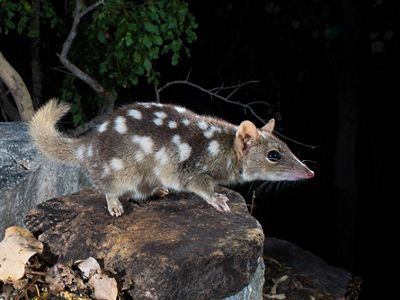Media Contacts
-
Tony Jupp
Associate Director of Communications
The Nature Conservancy Australia
Email: tjupp@tnc.org
Imagine you’re standing in the world’s largest intact tropical savanna. Hot and humid, you’re probably picturing yourself building up a thirst in an open woodland with lots of bothersome insects. Maybe you’re even hoping to see a lion or a tiger? But you’re not in Africa or India. You’re actually much closer to home in northern Australia. And while our marsupial lions died out tens of thousands of years ago, our northern savannas are still rich with a high diversity of native mammals.
However, that species richness is under enormous threat. The alarming decline of our northern mammals is cause for concern but a recent study funded by The Nature Conservancy and the Northern Territory Department of Environment and Natural Resources has shown positive signs of a way forward.
In collaboration with the Indigenous Land Corporation (ILC), the study included an extensive camera trapping survey across Fish River Station and adjoining properties – Tipperary Station and the Upper Daly Land Trust (see map below). Fish River Station is a property managed for conservation by the ILC.
“Despite it only recently being purchased for conservation, Fish River Station retains surprisingly high mammal diversity compared to many other parts of the Top End,” explains Dr James Fitzsimons, Director of Conservation for The Nature Conservancy in Australia. In fact, at least 13 native mammal species were detected in the survey (see table below) including two threatened species – the Northern Quoll and the Black-footed Tree-rat (or Djintamoonga) – and three others which are declining throughout northern Australia.

Evidence, consistent with other studies, suggests that ‘better’ fire regimes instigated at Fish River and carried out by the Indigenous Rangers there, are favouring more native mammal species than ‘poorer’ regimes. Dr Graeme Gillespie, Director Terrestrial Ecosystems at the Department of Environment and Natural Resources is excited by the findings. “This is very encouraging for the team at Fish River and gives us confidence that continuing to improve the fire regimes on Fish River Station will enhance biodiversity conservation”, he said.
Debby Cox, Station Manager at Fish River agrees. “Getting the fire regimes right is a great start”, she said. “Our next priority is more effectively tackling the challenges of the large feral herbivores, especially buffalo”.
By continuing to improve and support Indigenous Ranger management of our tropical savannas, they have a better chance of retaining their precious native mammals for a healthier ecosystem so that future generations don’t have to just imagine what it’s like to stand in the largest intact tropical savanna on Earth – they can experience for themselves.


Native mammals detected in the study at Fish River Station and surrounds
- Agile Wallaby
- Antilopine Wallaroo*
- Black-footed Tree-ratts
- Common Brushtail Possum*
- Common Rock Rat
- Common Wallaroo (Euro)
- Dingo
- Northern Brown Bandicoot*
- Northern Quollts
- Short-beaked Echidna
- Short-eared Rock-wallaby
- various dunnarts
- other non-specific native rodents
ts = threatened species * = Declining througout northern Australia
The Nature Conservancy is a global conservation organisation dedicated to conserving the lands and waters on which all life depends. Guided by science, we focus on getting things done efficiently and with the greatest positive impact for conservation. We’re a trusted organisation working in more than 70 countries and territories around the world on innovative solutions to our world’s toughest challenges so that nature and people can thrive together. To learn more about The Nature Conservancy in Australia, follow us on Facebook.
